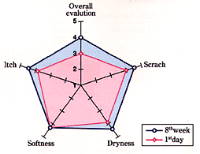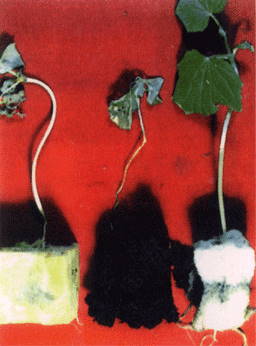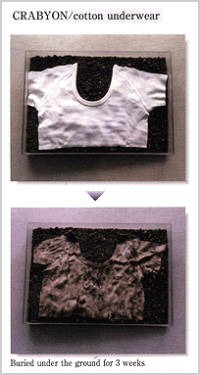|

Crabyon Safety Data Sheet

Crabyon
Acute Toxicity Test
(Chitin)
LD 50(lethal dose 50): Over 3,000mg/Kg
The term lethal dose 50 is defined as the dose of a
substance which is fatal to 50% of the test animals.
More specifically. Lethal dose 50 means that if chitin
is orally administered to mice on the basis of
3,000mg/Kg (mouse weight), 50% of them die.
Mutagenicity
Test (Chitin)
Mutagenicity Test: Negative
This test is conducted to determine whether or not
the test animals undergo an abrupt change in the
genotype of organ.
Positive: Mutagenic
Negative: not Mutagenic
Skin irritation Patch Test *
Patch Test: 1B (almost negative)
To be in compliance with JAFET (Japanese Association
for the Functional Evaluation of Textile), the fabric
in question has to be at least almost negative.
* A test in which
material is applied and left in contact with skin
surfaces for 48 hours to check tissue sensitivity.
Clinical tests of whether "CRABYON
underwear" will improve patients of atopic dermatitis.
Purpose
The objective is to determine whether CRABYON, with
many characteristics can alleviate the symptom of
atopic dermatitis.
Tester of CRABYON
underwear
A doctor of medicine who runs a pediatrics in Osaka,
Japan.
Test Specimen
Half-sleeved underwear of blended fabric (30% Crabyon
/ 70% cotton).
Testers (patients)
The doctor selected 11 patients from among his
outpatients, whose symptoms are relatively stable and
whom he can be reach easily for consultation.
a. Test period: January to March, 1996
b. The number of testers: 11 patients
c. Age: Children of 2 year 3 month to 11 years 3 month
old.
Test Method
All 11 testers wore CRABYON underwear after obtaining
their parents consent. Three pieces of underwear were given
to each testers who wore them one after another
and were washed after each use. The doctor and parents
saw each tester every two weeks. After eight weeks, he
evaluated whether or not the CRABYON underwear
improved patients of atopic dermatitis.
Efficacy Evaluation
| Category |
|
|
5
|
Improved
considerably |
|
4
|
Improved |
|
3
|
Improved
a little |
|
2
|
Remain
unchanged |
|
1
|
Aggravated |
|
a.
Doctor's Comments
He recorded the skin conditions such as itch, dryness
and scratches every two weeks and classified them into
five categories: |
| Category |
|
|
5
|
Very
effective |
|
4
|
Effective |
|
3
|
Somewhat
effective |
|
2
|
Not
effective |
|
1
|
Unknown |
|
b.
Overall Evaluation
Considering the skin conditions, use of medicine and
food, he classified the underwear's effectiveness into
five categories: |
|
Test
Results
|
|
2-3 years old
|
3
persons |
|
3-4
|
2 |
|
4-5
|
1 |
|
5-6
|
1 |
|
6-7
|
2 |
|
7-8
|
- |
|
8-9
|
1 |
|
9-10
|
- |
|
10-
|
1 |
|
|
11
persons |
|
a.
Testers Age Group |
| Category |
|
|
5 (improved
considerably)
|
"0"
persons |
|
4 (improved)
|
2 |
|
3 (somewhat
improved)
|
5 |
|
2 (remain
unchanged)
|
4 |
|
1 (aggravated)
|
0 |
|
b.
Test results
He classified the testers skin conditions as follows: |
He classified the effectiveness of CRABYON underwear
as follows: |
| Category |
|
|
5 (very
effective)
|
1
person (s) |
|
4 (effective)
|
1 |
|
3 (somewhat
effective)
|
4 |
|
2 (not
effective)
|
3 |
|
1 (unknown)
|
2 |
|
c.
Side effects
All 11 testers experienced no side effects of CRABYON
at the end of two month-long wear test. At the end of
the test, it is considered that the CRABYON underwear
is safe. |
|
d. Time dependent
change of skin conditions
Table 1 and Fig. 9 show how skin conditions changed
over time. (Weighted average of five categories)
|
|
Table1
- Time dependent change of skin conditions
|
|
|
Itch
|
Scratch
|
Dryness
|
Softness
|
Overall
evaluation
|
|
1
day
|
3.82
|
4.09
|
3.91
|
4.36
|
3.00
|
|
4
week
|
4.36
|
4.64
|
4.27
|
n.a
|
n.a
|
|
8
week
|
4.45
|
4.64
|
4.36
|
4.36
|
4.00
|
|
|

|
Comments
a. The CRABYON underwear, which 11 testers wore during the clinical test, is made of 30%
CRABYON / 70% cotton fabric. Treatment and sewing
were done by the process now commercially available
on the market.
The test period of January to March, 1996, was
dry and cold when people were susceptible to cold,
so we must admit that the time was rather
unfavorable for us to determine whether the
underwear served to alleviate the symptom of atopic
dermatitis.
All 11 testers were selected from among those who
have relatively stable, slight to less symptoms to
atopic dermatitis and who can see the doctor
regularly.
b. Among the 11 testers, there was one tester whose
symptom subsided considerably, one tester whose skin
conditions improved, four testers whose skin
conditions improved and two testers whose symptoms
of atopic dermatitis could not be evaluated
accurately because
(1) one of them developed the symptom of asthma, being in bad physical condition,
(2) one of them changed medicines, making it
difficult to determine the effectiveness of the
CRABYON underwear and
(3) a mother who was too
conscious of her child's atopic dermatitis overdosed
her child, hoping it might improve the skin
condition.
Even after considering the existence of such a
mother, more than half of the 11 testers somewhat
improved in skin conditions and one tester improved
considerably; we think that the underwear is
effective in improving the patients of atopic
dermatitis.
c. All the CRABYON underwear used in clinical
tests was dyed with fluorescent dyes and made with
conventional sewing process. Some of the 11 testers parents said that, since the CRABYON underwear was
soft to the skin even after repeated washings, they
were able to use it without any worry.
Test
of plant disease-resistance
Test method
Moistened cucumber seeds were planted on rock wool
bed, bark block bed, CRABYON-non-woven fabric bed in a
glass-house.
After two weeks plant disease bacteria, Phytophorame
Langeae, was inoculated into cucumbers and resistance
was checked one week after inoculation.
Result
As is shown in the photograph, CRABYON bed proved to
be more resistant to the disease than other beds.
The biodegradability of
CRABYON
Since CRABYON is made of organic
material
Chitin/Chitosan and cellulose, its biodegradability is
excellent. It begins to be decomposed by bacteria 2
weeks to 2 months after being buried underground,
which is almost the same as in the case of natural
fallen leaves.

Fig.10 Result of test.
Rock wool: left. Bark block: center. CRABYON: right.
|

Fig. 11 Test of biodegradability |
Main
Chitosan page can be found here
| 




